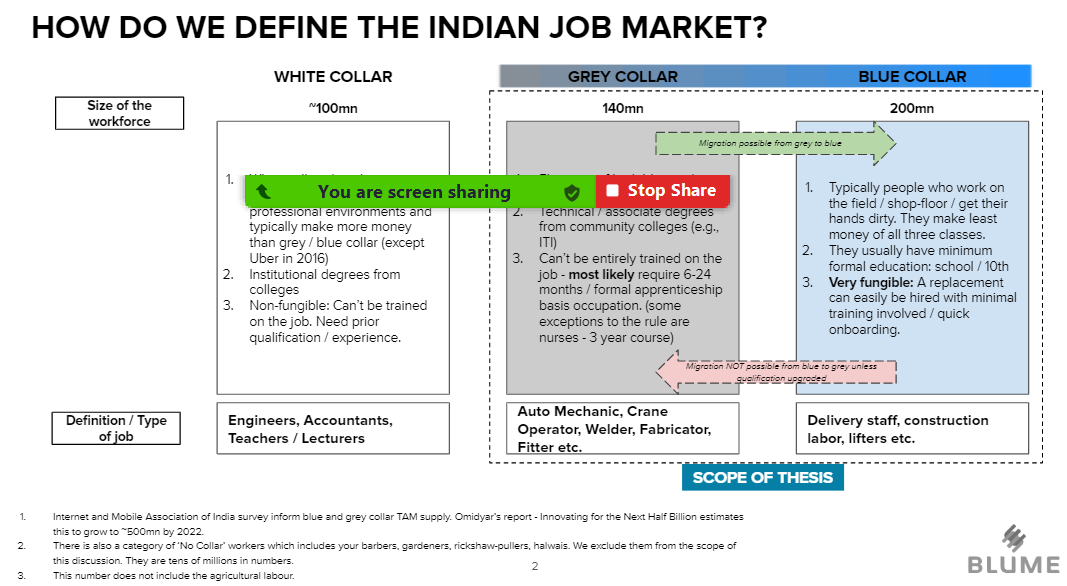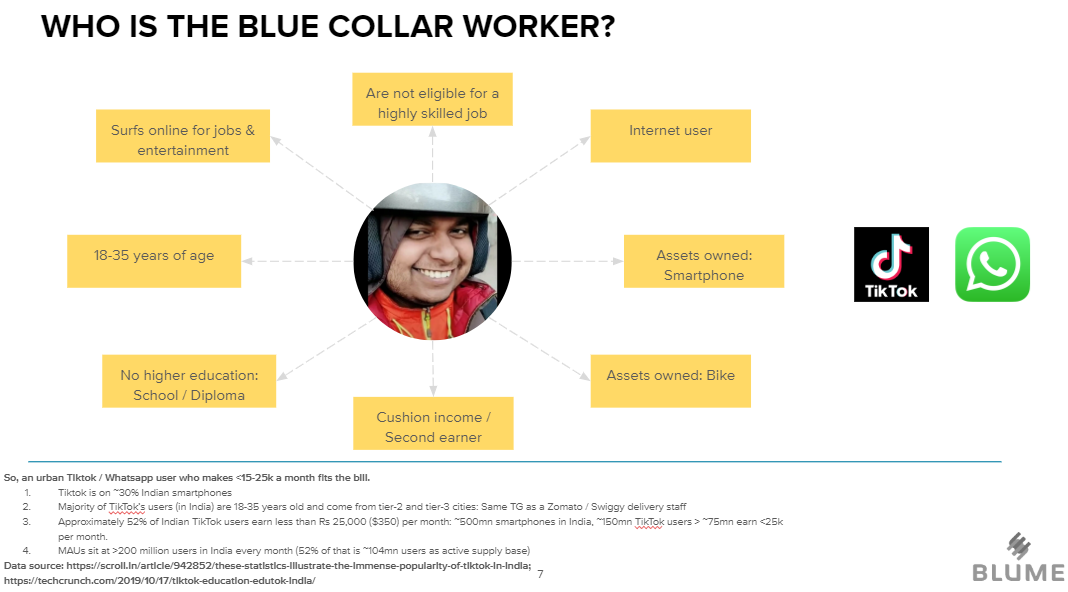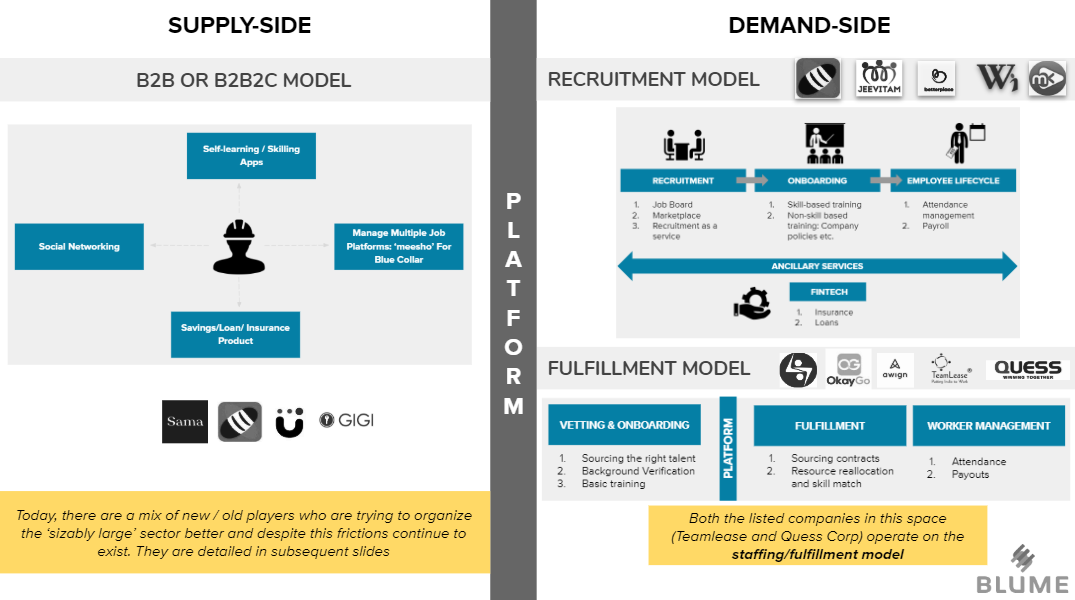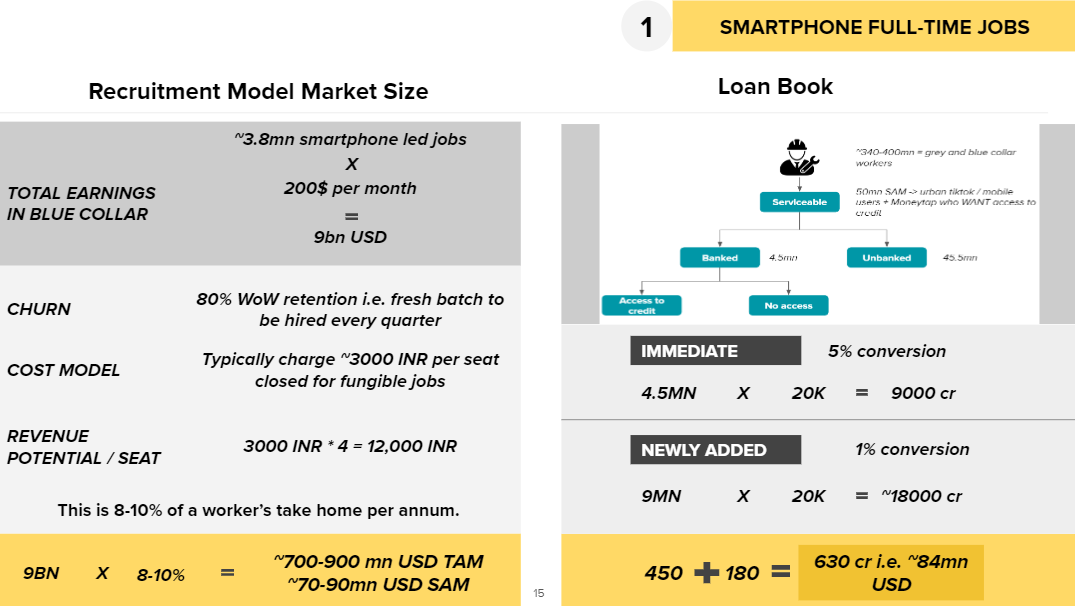@DikshaLahoti and I recently concluded a thesis on #bluecollar workforce in India - the exercise helped us develop a strong view on the space!
Capturing key insights from the thesis in a thread below
@sajithpai @BlumeVentures
(1/n)
Capturing key insights from the thesis in a thread below
@sajithpai @BlumeVentures
(1/n)
Definition of a blue-collar worker has changed over the years and today it definitely is not limited to traditional roles in warehousing, construction, manufacturing, and sanitation but has evolved to include jobs created by smartphones and the internet (jiofication).
(2/n)
(2/n)
So, who is this worker? Image  https://abs.twimg.com/emoji/v2/... draggable="false" alt="👇" title="Rückhand Zeigefinger nach unten" aria-label="Emoji: Rückhand Zeigefinger nach unten"> + job is typically mechanical & fungible i.e. requires min to no formal education & can be trained on the job. In the COVID context, those who are either migrating back to the villages or are not working from WFH are blue collar workers.
https://abs.twimg.com/emoji/v2/... draggable="false" alt="👇" title="Rückhand Zeigefinger nach unten" aria-label="Emoji: Rückhand Zeigefinger nach unten"> + job is typically mechanical & fungible i.e. requires min to no formal education & can be trained on the job. In the COVID context, those who are either migrating back to the villages or are not working from WFH are blue collar workers.
(3/n)
(3/n)
EVOLUTION OF THE SPACE: Here& #39;s how the bluecollar space reacted to macro factors. With massive tailwinds and growth in the space, we bet that the ‘Future of Blue Collar’ is rightly here!
(4/n)
(4/n)
Opportunity map: We& #39;ve come up with a mental map to view #bluecollar segment holistically: the framework divides the segment into 4 parts: smartphone+full time (SFT), smartphone+part time (SPT), traditional+full time (TFT), traditional+part time (TPT)
@BlumeVentures
(5/n)
@BlumeVentures
(5/n)
On the LHS, we see traditional jobs where we see two dominant categories - ‘Labour Naka’ and ‘Aspirational’ jobs.
On the RHS, we see new-age online jobs such as drivers, surveyors, marketers and influencers Amazon, Zomato, Ola, Dunzo, Milkbasket, etc
(6/n)
On the RHS, we see new-age online jobs such as drivers, surveyors, marketers and influencers Amazon, Zomato, Ola, Dunzo, Milkbasket, etc
(6/n)
Hence, opportunities -
(1) With the efficiency wave, we see TPT jobs (plumbers, electricians) moving to SFT platforms like @theurbancompany
(2) Another effect is simple digitisation: jobs (construction, lifters, movers) moving from TPT to SPT ( @Skilbee, Qikwork)
(7/n)
(1) With the efficiency wave, we see TPT jobs (plumbers, electricians) moving to SFT platforms like @theurbancompany
(2) Another effect is simple digitisation: jobs (construction, lifters, movers) moving from TPT to SPT ( @Skilbee, Qikwork)
(7/n)
Supply-side: B2C or B2B2C apps like Utter
Demand-side: Recruitment Model | Fulfilment Model
Recruitment model (Betterplace, MyKaam) - bluecollar version of Naukri - provides end-to-end recruitment services or operate on a lead gen model where the key asset is the workforce
(8/n)
Demand-side: Recruitment Model | Fulfilment Model
Recruitment model (Betterplace, MyKaam) - bluecollar version of Naukri - provides end-to-end recruitment services or operate on a lead gen model where the key asset is the workforce
(8/n)
Fulfillment Model (Qikwork, Okaygo, @futworkindia) // an emerging demand-side model where they provide end-to-end fulfillment of a task and here the real asset delivered is the completed project/task as against the workforce
(9/n)
(9/n)
Market Size: Conservatively @ USD800mn for a fullstack player. (Factors: #jobs created every year, churn, cost per hire)
Avg earnings per bluecollar worker is 15k & startups charge about ₹3000 per hire!
Fintech: ~60 mn USD for the banked
(10/n)
Avg earnings per bluecollar worker is 15k & startups charge about ₹3000 per hire!
Fintech: ~60 mn USD for the banked
(10/n)
Note that we keep adding active internet users as we speak + more and more of the supply gets banked & financially active. Hence, the approach is conservative. (Teamlease / Quess already at market cap of 3000+ cr each)
(11/n)
(11/n)
While we’ve tried to present a summary of the thesis, you can access the publicly viewable deck by clicking through this link - https://tinyurl.com/blumeonbluecollar
https://tinyurl.com/blumeonbl... href="https://twitter.com/BlumeVentures">@BlumeVentures @arpiit @sajithpai @BKartRed @sanjaynath @DikshaLahoti
(n-1/n)
(n-1/n)
Finally a shout out to @virkashyapp @sun1tha_v @DunzoIt @Cashify_ @SkillBee @GigForce @labournet and many more who helped us understand this space better!
FIN.
FIN.
Correcting a tag on my ^ original tweet:
Meant to tag @vk01 Vir Kashyap (Cofounder, Babajobs) on the thread - thank you Vir for sharing your amazing insights with us!
Meant to tag @vk01 Vir Kashyap (Cofounder, Babajobs) on the thread - thank you Vir for sharing your amazing insights with us!

 Read on Twitter
Read on Twitter
 + job is typically mechanical & fungible i.e. requires min to no formal education & can be trained on the job. In the COVID context, those who are either migrating back to the villages or are not working from WFH are blue collar workers.(3/n)" title="So, who is this worker? Image https://abs.twimg.com/emoji/v2/... draggable="false" alt="👇" title="Rückhand Zeigefinger nach unten" aria-label="Emoji: Rückhand Zeigefinger nach unten"> + job is typically mechanical & fungible i.e. requires min to no formal education & can be trained on the job. In the COVID context, those who are either migrating back to the villages or are not working from WFH are blue collar workers.(3/n)" class="img-responsive" style="max-width:100%;"/>
+ job is typically mechanical & fungible i.e. requires min to no formal education & can be trained on the job. In the COVID context, those who are either migrating back to the villages or are not working from WFH are blue collar workers.(3/n)" title="So, who is this worker? Image https://abs.twimg.com/emoji/v2/... draggable="false" alt="👇" title="Rückhand Zeigefinger nach unten" aria-label="Emoji: Rückhand Zeigefinger nach unten"> + job is typically mechanical & fungible i.e. requires min to no formal education & can be trained on the job. In the COVID context, those who are either migrating back to the villages or are not working from WFH are blue collar workers.(3/n)" class="img-responsive" style="max-width:100%;"/>






